Are you a successful person who owns your behavioral strengths and doesn’t ignore your development areas?
You are most engaged when you’re able to tap into your strengths. Behavioral strengths feel more comfortable and motivating, while development areas feel more challenging and energy draining. A better understanding of your strengths and development areas lead to confident self-awareness. However, self-awareness is still only one piece of the puzzle. Your goal is to learn how and when to modify your behaviors to improve communication, interactions, relationships—and ultimately; success.
Overview
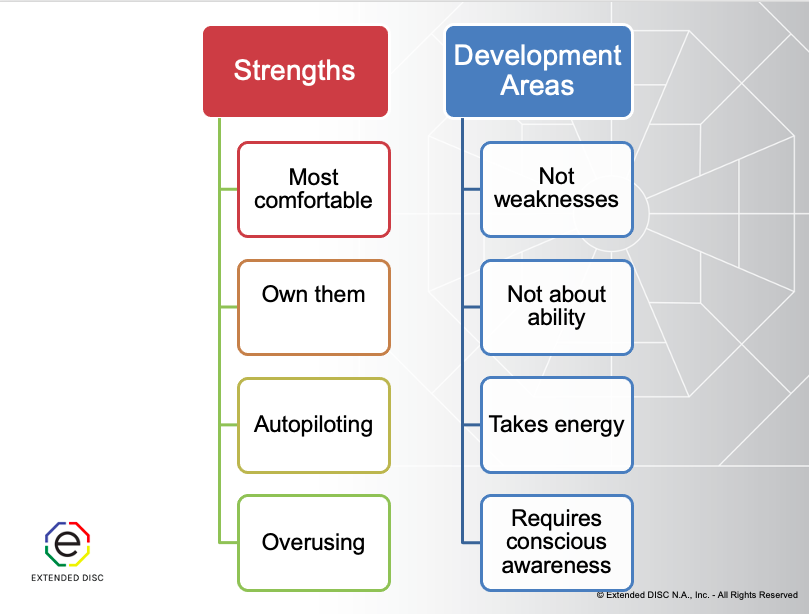
The Extended DISC® Assessment describes your strengths as behaviors that feel most comfortable to you; basically, you own them. Alas, you don’t automatically rock them because it’s not about ability. Strengths can end up as a liability when you overuse them. You tend to rely on your strengths because they don’t take conscious thought or energy. Sometimes, you rely on them too much and end up overusing them. For example, if you’re a talker, have you ever gotten into trouble for talking too much?
Development areas are not automatically your weaknesses. They are behaviors that don’t feel natural and take more energy. We may even try to avoid them. However, our roles and responsibilities often require us to push outside our behavioral comfort zone. Can you do it? Of course; especially if you have a starting point! Try thinking of your behavioral development areas as challenges you can certainly develop if you tried.
Knowing your strengths will help you tap into them and knowing your development areas provides opportunities to manage them. It really comes down to energy; strengths don’t require energy and development areas do.
Next, let’s look at the strengths and challenges for each of the main DISC styles.
D-style strengths and challenges
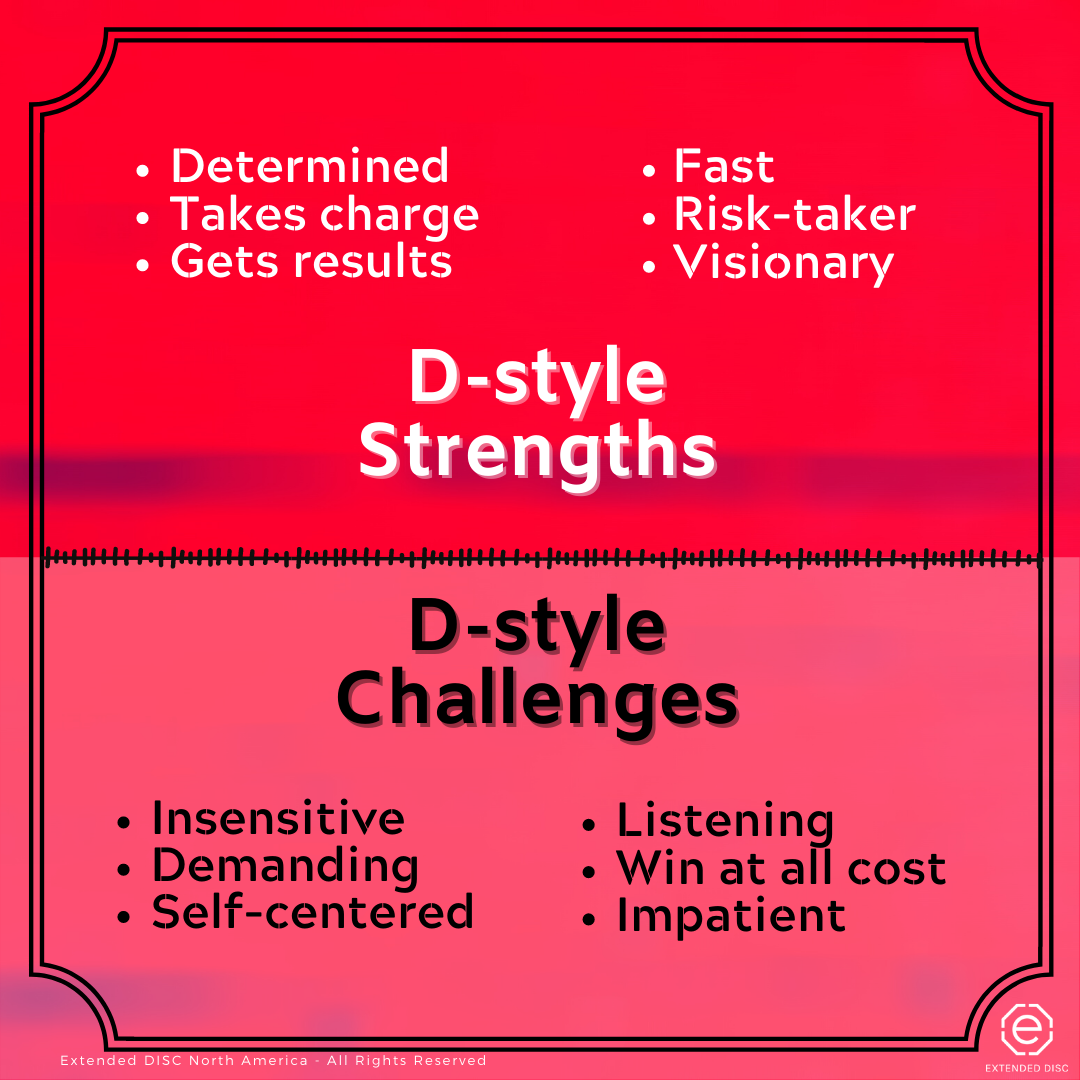
D-styles are your independent task-focused styles. They rely on their determination and preference for taking charge to make things happen and achieve results. They think outside the box and thrive in fast-paced environments. D-styles are willing to take risks to achieve great rewards, which, oftentimes benefit the rest of us.
We tend to see the challenges in our D-style colleague as being insensitive and self-centered. They can tunnel vision on their own tasks and accomplishments. Their laser focus can cause them to ignore input from others. The fast-paced D-styles can come across as demanding and impatient multi-taskers. Their need to control interactions creates a unidirectional way of communication; they speak and you listen.
D-styles can make better adjustments with conscious awareness and practice. They can slow down, listen more, and be more patient. D-styles can sometimes get faster results if they set aside some time for small talk or listening more.
I-style strengths and challenges
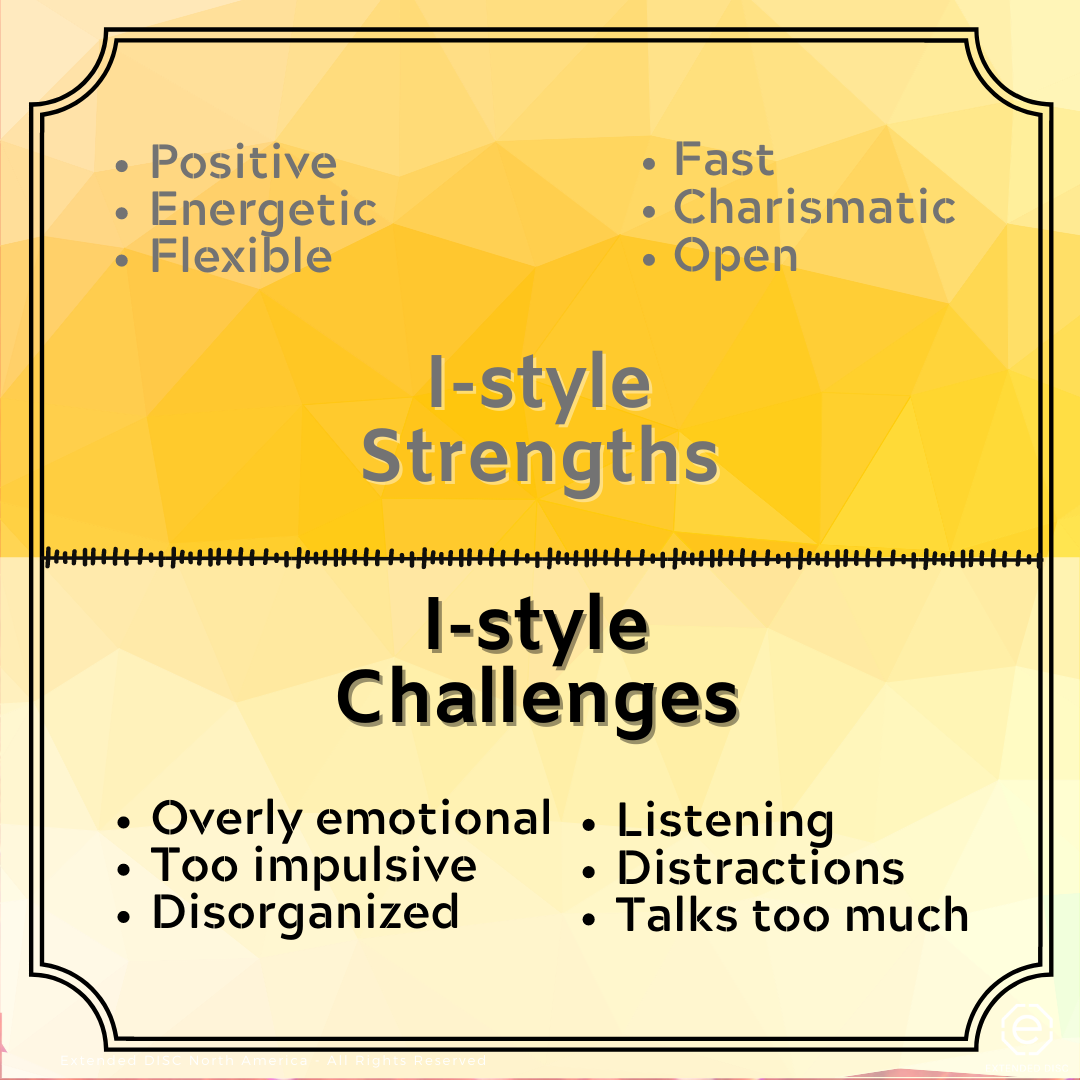
We love the I-style’s enthusiasm and optimism. Their energy and emotion show on the surface. They are charismatic and sell their ideas well. I-styles are flexible and use their sociability to set the positive tone for our team and connect people.
Challenges for the I-style are being overly emotional and easily distracted. They are social butterflies, but they can end up talking when they should be listening. I-styles prefer variety and focusing on the big picture so details and tasks can create disorganization.
I-styles should rely on their ability to communicate verbally, but know that sometimes it’s more productive to focus on the topic and listen. They can slow it down and focus more on facts before making decisions.
S-style strengths and challenges
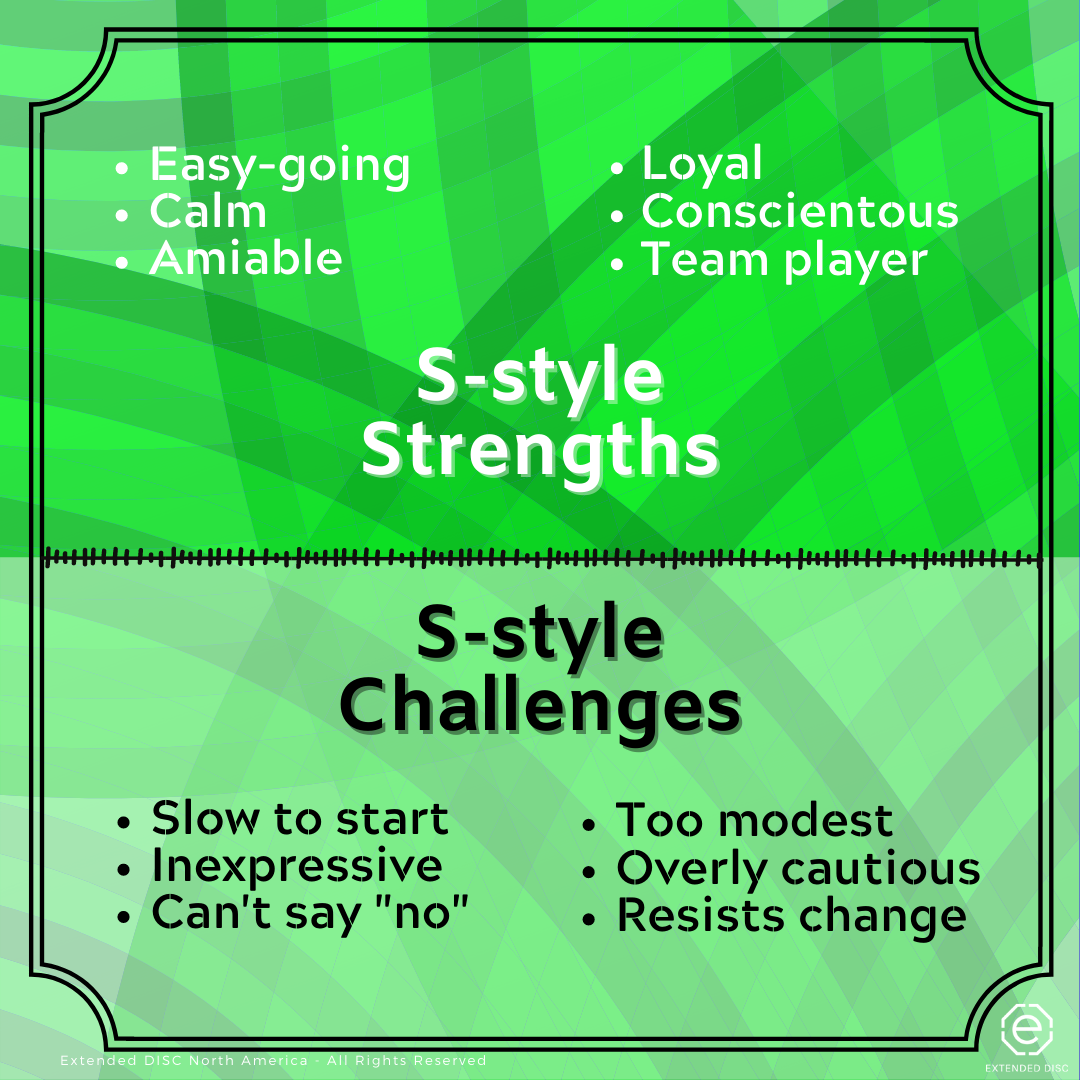
We count on our S-styles to be calm and steady. They are the team players of the DISC styles. We count on their loyalty and dependability. S-styles strive to build strong relationships and are very conscientious. They use their strengths to support their team and create a stable and dependable team environment.
As the team player of styles, the challenges for the S-style, is their inability to say “no.” S-styles may be too modest and therefore, do not speak up. Their desire for stability can make them more resistant to change and overly cautious. We describe S-styles as indecisive and slow to start; they desire other’s viewpoints and want to make decisions that have a positive impact on the people around them.
S-styles can practice speaking up and verbalizing their thoughts and emotions. They may even realize that it wasn’t so bad to just jump in and do it.
C-style strengths and challenges
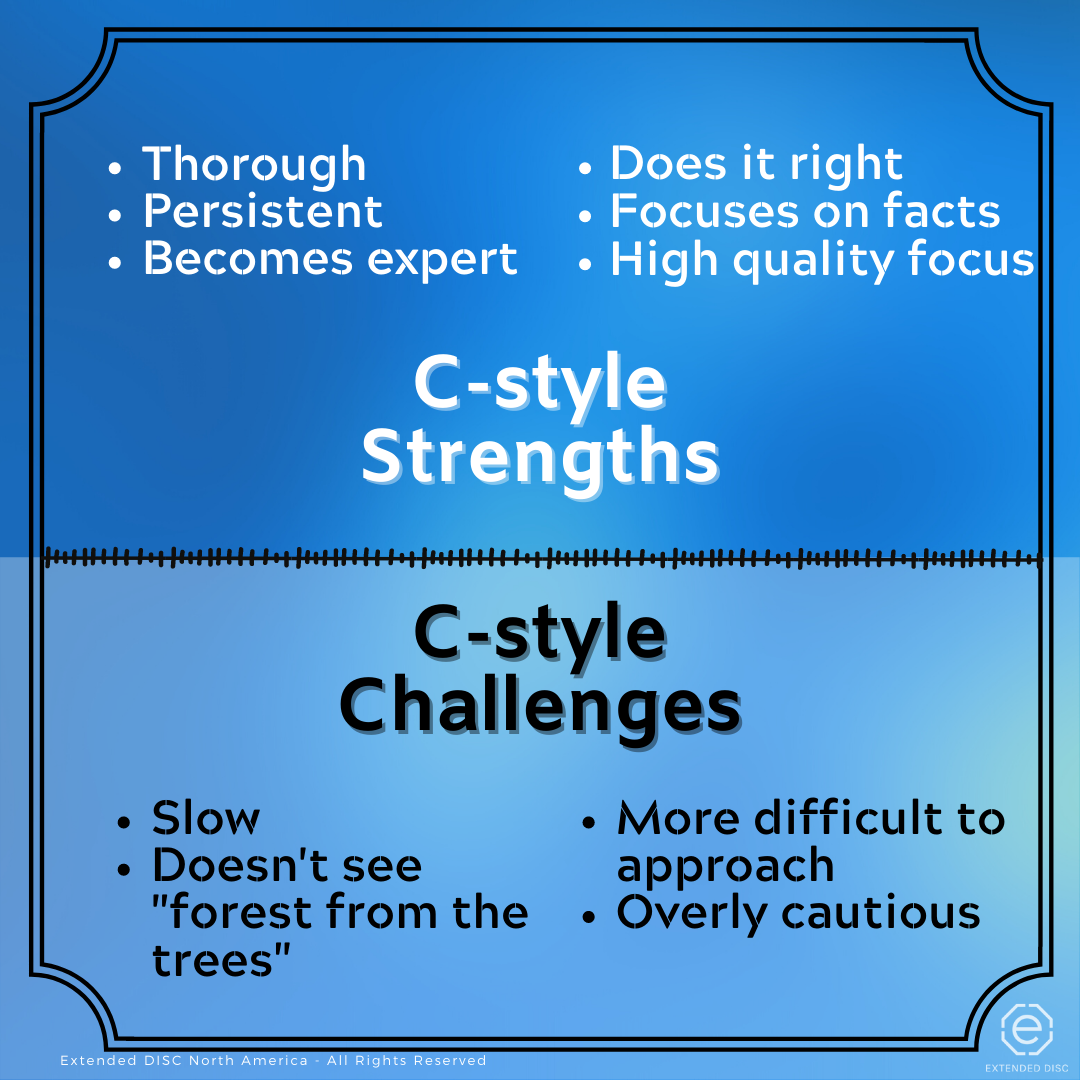
Who do we run to when we have a problem to solve? Typically, it is our team’s expert, the C-style. They are more focused on doing things correctly and taking time to understand the processes and products. They are our voice of reason and facts.
A challenge for C-styles is their desire for perfection. Their focus on details can sometimes prevent them from “seeing the forest from the trees.” They tend to move slowly and cautiously because the process needs to be logical and correct. They are more reserved so others may find them difficult to approach.
C-styles can challenge themselves to speaking up and focusing more on people, rather than details and facts. They can work on being more expressive so they don’t appear distant. They can practice letting go of mistakes because sometimes mistakes are just part of the learning process.
Using your strengths and taking on your challenges

Some of us stick to our path to success and don’t consider the need to change, “hey, it’s been working for me all this time!” At some point, our style will not be the best fit and knowing when and how to adjust is the magic key.
However, don’t overlook your strengths; recognize them and use them because your job is tough enough! Don’t take your strengths for granted and assume ‘everyone can do that.” If you are thorough and methodical, don’t assume others are the same. Autopiloting on our strengths can happen when we get too comfortable; alway remember to make appropriate adjustments in your daily interactions.
Be aware that strong emotions, such as stress and frustration, can divert your energies away from behavior modification. Your focus on managing those strong emotions can cause you to rely only on your strengths; sometimes, overusing them.
Next steps

Consider your own strengths and whether you’re taking advantage of these valuable behavioral traits. However, don’t overuse them to which they become a liability to your performance. Ask yourself these questions to maximize your strengths and address your challenges:
- What strengths are you currently capitalizing on?
- How have they specifically contributed to your success?
- Can you use them more effectively? If so, how?
- Can you identify situations when you’ve overused a strength?
- What can you do differently going forward?
- Are their any additional strengths you should be capitalizing on in your current position?
- State a current goal and identify how you can use your strengths to achieve the goal.
- Which of your behavioral challenges, if addressed, creates a significant impact on your performance?
- What are the specific actionable steps you will implement to take on these challenges?
By increasing your understanding of your behavioral strengths and challenges, you are that much closer to making better decisions on how to be more successful.
